The Whole House Approach

At 21 Degrees, we believe that creating a truly exceptional home goes beyond simply assembling a collection of high-quality components. It requires a holistic vision, a deep understanding of building physics, and an unwavering commitment to a unified design philosophy. This is the essence of the Whole House Approach – a methodology that lies at the very heart of everything we do.
Beyond the Sum of its Parts
Too often, the process of designing and building a home becomes fragmented. Decisions about insulation are made in isolation from the heating system, and ventilation is considered an afterthought to airtightness. This piecemeal approach can lead to a building that, while seemingly well-equipped, fails to perform as a cohesive and efficient system. The result can be a home that is uncomfortable, costly to run, and prone to issues like condensation and mould.
The Whole House Approach, in contrast, treats a building as a single, integrated entity. It recognises that every element, from the foundations to the roof, is interconnected and has a direct impact on the overall performance of the building. By considering the house as a complete system, we can ensure that all its components work in harmony to create a home that is not only energy-efficient but also a healthy and comfortable place to live.
The Four Pillars of a High-Performing Home
Our Whole House Approach is built upon four fundamental principles, each of which is crucial for achieving a low-energy, sustainable, and comfortable building:
- Insulation: The first line of defence against heat loss is a continuous and robust insulation layer. We meticulously design and specify insulation for every part of the building envelope – walls, floors, and roof – to minimise thermal bridging and ensure a consistent internal temperature.
- Airtightness: A building's airtightness is a critical factor in its energy efficiency and comfort. By creating a draught-free and airtight building envelope, we can prevent uncontrolled heat loss and ensure that the ventilation system can operate as intended.
- Heating: With a highly insulated and airtight building, the heating demand is significantly reduced. This allows us to design and install smaller, more efficient heating systems that are perfectly matched to the building's requirements, further reducing energy consumption and running costs.
- Ventilation: In an airtight home, a controlled ventilation system is essential for maintaining good indoor air quality. We specify mechanical ventilation with heat recovery (MVHR) systems that provide a constant supply of fresh, filtered air while recovering the heat from the outgoing stale air. This ensures a healthy and comfortable indoor environment without compromising the building's energy efficiency.
A Synergy of Systems
The true power of the Whole House Approach lies in the synergy between these four pillars. A well-insulated building requires a smaller heating system. An airtight building needs a controlled ventilation system. And a balanced combination of all four results in a home that performs to the highest standards of comfort, cost-effectiveness, and carbon efficiency.
By embracing this holistic philosophy, we can deliver homes that are not just buildings, but finely-tuned systems for living. Homes that are a pleasure to live in, inexpensive to run, and have a minimal impact on our planet. This is the 21 Degrees commitment – a promise of better buildings, designed for life.







